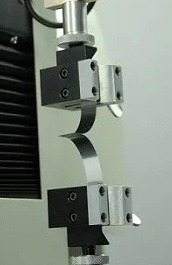Source:Link Testing Instruments Co.,Ltd.
For dry composite films, the composite fastness between the single-layer films that make up the composite film mainly depends on the wetting state of the adhesive on the surface of the film, the amount of coating, and the strength of the adhesive. Any link that affects the above factors may adversely affect the composite fastness of the composite film. In order to identify the goods and improve the aesthetics of the packaging, the composite film for packaging generally does not lack the element of colorful printing patterns, and the compatibility of the ink used in printing and the adhesive will make the composite film firm. For example, the mutual permeability of ink and adhesive is poor, and it is difficult for the adhesive to penetrate to the surface of the substrate. When the composite film is peeled off and damaged, the ink layer is pulled down by the adhesive, resulting in a decrease in the peel strength of the composite film at the printing site.
In addition, if the content of additives in the ink is high, it will interfere with the surrounding adhesives and cause the composite fastness around the printed part to decrease. Different colors of ink have different effects on the composite fastness of the composite film, which is also one of the main reasons for the difference in peel strength of the printed area of some composite film materials with different colors. The problem of uneven composite fastness of composite film materials. After it is used for product packaging, when it is rubbed or flexed by external force, it is easy to delaminate on the parts with poor composite fastness, which affects the product’s performance. The appearance reduces the grade of the product, and at the same time, it is easy to cause deterioration of the barrier properties, puncture resistance, impact resistance and other physical and mechanical properties of packaging materials, which in turn leads to a series of problems such as oxidation deterioration, deliquesce, and bag breakage. Therefore, it is particularly important to strengthen the detection of the influence of the ink on the composite fastness of the composite film.
Test methods and test equipment
The composite fastness of the composite film is verified by the peel strength test. The method standard for this testing process is GB 8808-1988 "Soft Composite Plastic Material Peel Test Method", which is the main standard for the peel strength test of the composite film.
Test sample and test process
Test sample: This article uses a partially printed plastic composite film produced by dry composite as the test sample.
Experimental procedure:
(1) Place the sample in a laboratory environment at 23±2 ℃ and 45 ~ 55% RH for 5 hours.
(2) Cut 5 specimens each with a width of 15.0 mm and a length of 200 mm from the printed part and the non-printed part of the sample in the longitudinal direction.
(3) Manually peel off the sample along the length of each sample to a length of about 50 mm.
(4) Set the test speed, sample width, thickness, quantity and other test parameters on the control software of the intelligent electronic tensile testing machine.
(5) Clamp the two ends of the stripped part of the sample in the upper and lower clamps of the equipment, so that the longitudinal axis of the stripped part of the sample coincides with the center lines of the upper and lower clamps.

(6) Click the test option, the test starts, the device automatically records and displays the force curve during the peeling process of the sample in real time, and reports the test result of the final peel strength.
(7) Repeat operations (5) and (6) until all 10 samples have been tested.
Test results and analysis
The average value of the peel strength of the five printed samples of the plastic composite film sample tested is 0.951 N/15mm, and the average value of the peel strength of the five samples of the non-printed portion is 2.133 N/15mm. Therefore, the peel strength of the printed part is significantly lower than that of the non-printed part, and the ink has a serious impact on the composite fastness of the plastic composite film.
In the film compounding process, there are many factors that affect the compound fastness of the compound film, and ink is one of them. In this paper, a sample of a dry composite plastic composite film is used as an example. The LTS-05S tensile testing machine is used to test the composite fastness of its printed and non-printed parts to verify whether the ink used for printing is It has an effect on the composite fastness of the sample. The test operation is simple, the equipment has a high degree of automation, and the test results have high precision and good accuracy, which can truly reflect the composite fastness of the tested samples. LTS-05S tensile testing machine is a cost-effective packaging performance testing equipment. In addition to the peel strength of the composite film mentioned in this article, it can also be used for the tensile performance, puncture performance, heat seal strength, and opening of the film. The detection of multiple performance indicators such as performance and tearing performance meets the various testing needs of customers.
For more details please visit www.linktesting.org